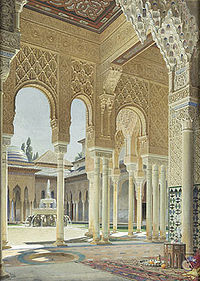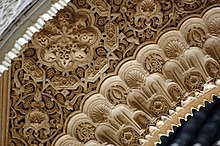
The Alhambra
The Alhambra ( /ælˈhæmbrə/; Spanish: [aˈlambɾa]; Arabic: الْحَمْرَاء, trans. al-Ḥamrā; literally "the red one"), the complete form of which was Calat Alhambra (Arabic: الْقَلْعَةُ ٱلْحَمْرَاءُ, trans. al-Qal‘at al-Ḥamrā’,
"the red fortress"), is a palace and fortress complex located in the
Province of Granada, Spain. It was constructed during the mid 14th
century by the Moorish rulers of the Emirate of Granada in al-Andalus,
occupying the top of the hill of the Assabica on the southeastern border
of the city of Granada.
/ælˈhæmbrə/; Spanish: [aˈlambɾa]; Arabic: الْحَمْرَاء, trans. al-Ḥamrā; literally "the red one"), the complete form of which was Calat Alhambra (Arabic: الْقَلْعَةُ ٱلْحَمْرَاءُ, trans. al-Qal‘at al-Ḥamrā’,
"the red fortress"), is a palace and fortress complex located in the
Province of Granada, Spain. It was constructed during the mid 14th
century by the Moorish rulers of the Emirate of Granada in al-Andalus,
occupying the top of the hill of the Assabica on the southeastern border
of the city of Granada.
The Alhambra's Moorish palaces
were built for the last Muslim Emirs in Spain and its court, of the
Nasrid dynasty. After the Reconquista (reconquest) by the Reyes
Católicos ("Catholic Monarchs") in 1492, some portions were used by the
Christian rulers. The Palace of Charles V, built by Charles V, Holy
Roman Emperor
in 1527, was inserted in the Alhambra within the Nasrid fortifications.
After being allowed to fall into disrepair for centuries, the Alhambra
was "discovered" in the 19th century by European scholars and travelers,
with restorations commencing. It is now one of Spain's major tourist
attractions, exhibiting the country's most significant and well known
Islamic architecture, together with 16th-century and later Christian
building and garden interventions. The Alhambra is a UNESCO World
Heritage Site, and the inspiration for many songs and stories.
Setting
Moorish poets described it as "a pearl set in emeralds," in allusion to the colour of its buildings and the woods around them.
The palace complex was designed with the mountainous site in mind and
many forms of technology were considered. The park (Alameda de la
Alhambra), which is overgrown with wildflowers and grass in the spring,
was planted by the Moors with roses, oranges and myrtles; its most characteristic feature, however, is the dense wood of English elms brought by the Duke of Wellington in 1812. The park has a multitude of nightingales
and is usually filled with the sound of running water from several
fountains and cascades. These are supplied through a conduit 8 km (5
miles) long, which is connected with the Darro at the monastery of Jesus del Valle, above Granada.
 In spite of the long neglect, willful vandalism and sometimes
ill-judged restoration which the Alhambra has endured, it remains an
atypical example of Muslim art in its final European stages, relatively
uninfluenced by the direct Byzantine influences found in the Mezquita of Córdoba.
The majority of the palace buildings are quadrangular in plan, with all
the rooms opening on to a central court; and the whole reached its
present size simply by the gradual addition of new quadrangles, designed
on the same principle, though varying in dimensions, and connected with
each other by smaller rooms and passages. The Alhambra was extended by
the different Muslim rulers who lived in the complex. However, each new
section that was added followed the consistent theme of "paradise on
earth". Column arcades, fountains with running water, and reflecting
pools were used to add to the aesthetic and functional complexity. In
every case, the exterior was left plain and austere. Sun and wind were
freely admitted. Blue, red and a golden yellow, all somewhat faded
through lapse of time and exposure, are the colors chiefly employed.
In spite of the long neglect, willful vandalism and sometimes
ill-judged restoration which the Alhambra has endured, it remains an
atypical example of Muslim art in its final European stages, relatively
uninfluenced by the direct Byzantine influences found in the Mezquita of Córdoba.
The majority of the palace buildings are quadrangular in plan, with all
the rooms opening on to a central court; and the whole reached its
present size simply by the gradual addition of new quadrangles, designed
on the same principle, though varying in dimensions, and connected with
each other by smaller rooms and passages. The Alhambra was extended by
the different Muslim rulers who lived in the complex. However, each new
section that was added followed the consistent theme of "paradise on
earth". Column arcades, fountains with running water, and reflecting
pools were used to add to the aesthetic and functional complexity. In
every case, the exterior was left plain and austere. Sun and wind were
freely admitted. Blue, red and a golden yellow, all somewhat faded
through lapse of time and exposure, are the colors chiefly employed.
The decoration consists, as a rule, of stiff, conventional foliage, Arabic inscriptions, and geometrical patterns wrought into arabesques. Painted tiles are largely used as panelling for the walls. The palace complex is designed in the Mudéjar, style which is characteristic of western elements reinterpreted into Islamic forms and widely popular during the Reconquista, the reconquest of the Iberian Peninsula from the Muslims by the Christian kingdoms.
LayoutThe Alhambra did not have a master plan for the total site design, so its overall layout is not orthogonal or organized. As a result of the site's many construction phases: from the original 9th century citadel, through the 14th century Muslim palaces, to the 16th century palace of Charles V; some buildings are at odd positioning to each other. The terrace or plateau where the Alhambra sits measures about 740 metres (2,430 ft) in length by 205 metres (670 ft) at its greatest width. It extends from west-northwest to east-southeast and covers an area of about 142,000 square metres (1,530,000 sq ft). The Alhambra's most westerly feature is the alcazaba (citadel), a strongly fortified position. The rest of the plateau comprises a number of Moorish palaces, enclosed by a fortified wall, with thirteen towers, some defensive and some providing vistas for the inhabitants. The river Darro passes through a ravine on the north and divides the plateau from the Albaicín district of Granada. Similarly, the Assabica valley, containing the Alhambra Park on the west and south, and, beyond this valley, the almost parallel ridge of Monte Mauror, separate it from the Antequeruela district. Another ravine separates it from the Generalife.Art and architectural details

After the Christian conquest of the city in 1492, the conquerors began to alter the Alhambra. The open work was filled up with whitewash, the painting and gilding effaced, and the furniture soiled, torn, or removed. Charles V (1516–1556) rebuilt portions in the Renaissance style of the period and destroyed the greater part of the winter palace to make room for a Renaissance-style structure which was never completed. Philip V (1700–1746) Italianised the rooms and completed his palace in the middle of what had been the Moorish building; he had partitions constructed which blocked up whole apartments. Over subsequent centuries the Moorish art was further damaged, and in 1812 some of the towers were destroyed by the French under Count Sebastiani. In 1821, an earthquake caused further damage. Restoration work was undertaken in 1828 by the architect José Contreras, endowed in 1830 by Ferdinand VII. After the death of Contreras in 1847, it was continued with fair success by his son Rafael (d. 1890) and his grandson. Designed to reflect the very beauty of Paradise itself, the Alhambra is made up of gardens, fountains, streams, a palace, and a mosque, all within an imposing fortress wall, flanked by 13 massive towers. History
The literal translation of Alhambra, "red fortress," reflects the color of the red clay of the surroundings of which the fort is made. The buildings of the Alhambra were originally whitewashed; however, the buildings seen today are reddish. The first reference to the Qal‘at al-Ḥamra was during the battles between the Arabs and the Muladies (people of mixed Arab and European descent) during the rule of the ‘Abdullah ibn Muhammad (r. 888–912). In one particularly fierce and bloody skirmish, the Muladies soundly defeated the Arabs, who were then forced to take shelter in a primitive red castle located in the province of Elvira, presently located in Granada. According to surviving documents from the era, the red castle was quite small, and its walls were not capable of deterring an army intent on conquering. The castle was then largely ignored until the eleventh century, when its ruins were renovated and rebuilt by Samuel ibn Naghrela, vizier to the emir Bādīs of the Zirid Dynasty of Al Andalus, in an attempt to preserve the small Jewish settlement also located on the Sabikah hill. However, evidence from Arab texts indicates that the fortress was easily penetrated and that the actual Alhambra that survives today was built during the Nasrid Dynasty. 
The design included plans for six palaces, five of which were grouped in the northeast quadrant forming a royal quarter, two circuit towers, and numerous bathhouses. During the reign of the Nasrid Dynasty, the Alhambra was transformed into a palatine city, complete with an irrigation system composed of acequias for the gardens of the Generalife located outside the fortress. Previously, the old Alhambra structure had been dependent upon rainwater collected from a cistern and from what could be brought up from the Albaicín. The creation of the Sultan's Canal solidified the identity of the Alhambra as a palace-city rather than a defensive and ascetic structure. The Muslim ruler Muhammad XII of Granada surrendered the Emirate of Granada in 1492 without the Alhambra itself being attacked when the forces of Los Reyes Católicos, King Ferdinand II of Aragon and Queen Isabella I of Castile, took the surrounding territory with an overwhelming force of numbers. it not finish we continue | |
 Data Science Ar
Data Science Ar
0 comments:
Post a Comment